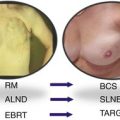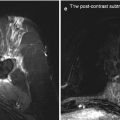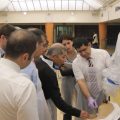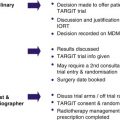Fig. 16.1
Increase in the number of breast cancer patients at the King Fahd Hospital, University of Dammam
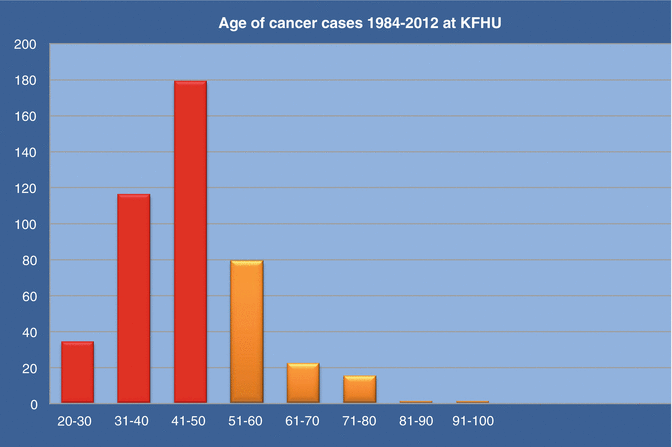
Fig. 16.2
Age distribution of breast cancer patients at the King Fahd Hospital, University of Dammam: 36 % of patients are below the age of 40 years
Among women in Arab communities, great cultural value is placed on body image. Anxiety about cancer detection and fear of breast loss consequently lead women to resist seeking help: breast cancer represents a cultural stigma to be dealt with in utmost secrecy. Women prefer to be silent sufferers who tolerate considerable distress before ultimately presenting with relatively advanced disease (Abdel Hadi 2000; Ravichandran et al. 2011).
The fact that strategies aimed at early detection have generally not succeeded over the years is attributable to the fact that the surgical options have not altered. Mastectomy tends to be offered to patients regardless of disease stage, and is reportedly used in as many as 80 % of cases (Ibrahim et al. 2005), in sharp contrast to figures from the Western world. Nevertheless, limited local campaigns aimed at raising awareness have shown a positive impact on early presentation, leading to a lower stage at diagnosis and making breast-conserving surgery a real possibility (Abdel Hadi 2000).
The scarcity of radiotherapy facilities in developing countries further compounds the problem. It has been reported that there are only 205 radiation therapy centres, 256 radiation oncologists and 1,216 radiation technologists in all Arab countries, as compared with 2,734, 2,683 and 4,518, respectively, in the USA, which has an equivalent population of about 300 million (El Saghir et al. 2007; http://www-naweb-iaea.org/nahu/dirac/query3.asp 2013). Furthermore, the radiation centres tend to be located in major cities and may be a considerable distance from the patient’s place of residence; the patient is then likely to be dependent on her male partner for travel arrangements. This, along with the fact that radiotherapy is often delivered over a protracted period of 3–4 weeks, results in disruption and non-compliance.
Due to the above limitations, it may not always be feasible to offer breast-conserving surgery followed by external beam radiotherapy. Intraoperative radiotherapy (IORT) is a major breakthrough in the treatment of breast cancer and represents an appealing option for our patients as it provides appropriate treatment for breast cancer in a single hospital visit.
The introduction of IORT at our institution nevertheless faced initial resistance the multidisciplinary team. This was soom overcame by a review of the scientific evidence and analysis of the data from the TARGIT randomised trial as well as the data from the TARGIT boost trial. We also presented a business case to the administration, which was looked upon positively.
We have been pleasantly surprised by the readiness of our culturally conservative patients to accept this new treatment modality, and their willingness to participate in the programme reflects their desperation to access breast-preserving options. Increased awareness about the availability of this innovative therapy has resulted in a steady increase in patients presenting with earlier disease.
This positive response from the community resulted in the founding of a scientific chair funded by the National Commercial Bank to support the IORT project for breast cancer treatment in the Eastern Province of Saudi Arabia.
Communication with pioneers in the field at University College London has supported the project by way of the provision of expertise and structured training through the TARGIT Academy. This has involved attendance of a core team of surgical and clinical oncologists and a radiation physicist at a 2-day training course in London, followed by proctored training by one of the experts in Dammam.
Once this process had been initiated, resistance slowly dissipated and the treatment modality was adopted, encouraging other centres to explore this therapeutic option as well.
As there are a small number of patients with early breast cancer in our centre, the use of IORT as a single fraction is limited. It can, however, be more extensively utilised as boost therapy during wide local excision in patients who have received neo-adjuvant chemotherapy, which is then followed by whole breast external beam radiation therapy (EBRT). The reported results of wide local excision and boost combined with EBRT have been favourable, with a low local recurrence rate, and this accordingly is an attractive option for our current setup. The accurate placement of applicators in the tumour bed and the immediacy of the treatment, which has a favourable effect on the tumour microenvironment, are key to the success of this therapy (Vaidya et al. 2006; Keshtgar et al. 2011).
Stay updated, free articles. Join our Telegram channel

Full access? Get Clinical Tree


